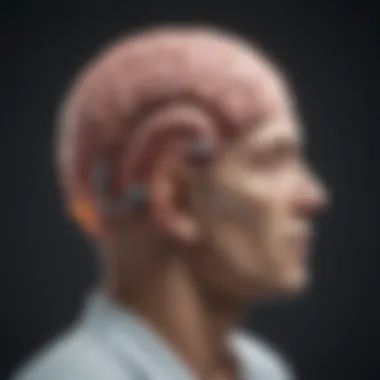Understanding Gamma Knife Treatment for Brain Metastases


Intro
Gamma knife treatment, often regarded as a precise and minimally invasive option, presents a significant advancement in the management of brain metastases. This therapeutic method utilizes highly focused gamma radiation to target and obliterate tumor cells in the brain while sparing healthy tissue. Brain metastases occur when cancer cells from other parts of the body spread to the brain. This article will delve into the fundamental principles behind gamma knife technology, the indications for its use, the procedural approach, and potential outcomes. It will also discuss complications that may arise, advantages and limitations of the treatment, and insights into patient selection.
Understanding gamma knife treatment is crucial for students, researchers, educators, and healthcare professionals. This treatment modality continues to evolve, driven by advancements in technology and a deeper understanding of brain metastases. Therefore, examining both the current landscape and future directions in gamma knife treatment is essential for enhancing patient care and treatment efficacy.
Prelims to Brain Metastases
Brain metastases refer to cancer cells that have spread to the brain from another part of the body. This condition is critical in oncology as it signals advanced disease and poses significant challenges for treatment. Understanding brain metastases is essential for both patients and healthcare providers. It has implications for prognosis and treatment strategies, influencing how patients are managed and cared for.
Definition and Overview
Brain metastases account for a substantial proportion of all brain tumors. These tumors are secondary in nature, meaning they originate from elsewhere in the body. This can include sites such as the lungs, breasts, or skin. The biological behavior of brain metastases varies based on the primary tumor type. Some metastases may grow quickly and invade surrounding brain tissue, whereas others might remain stable for extended periods. Understanding this distinction is crucial for developing effective treatment plans.
It is vital to recognize that symptoms can differ widely among patients. common indications include headaches, seizures, cognitive changes, or neurological deficits. Patients often present with various complaints, which can delay diagnosis. Prompt recognition and intervention are essential to managing symptoms and reducing morbidity associated with this condition.
Epidemiology of Brain Metastases
The incidence of brain metastases is on the rise, largely due to improved survival rates for many types of primary cancers. Studies suggest that approximately 20 to 40% of individuals with cancer will develop brain metastases during their illness. Risk factors include the primary cancer type, the stage of the disease, and underlying genetic factors. The most frequent cancers that lead to brain metastases include lung, breast, and melanoma.
Understanding the epidemiological trends assists in identifying at-risk populations. It also underlines the importance of regular monitoring in high-risk patients. Awareness of these statistics can emphasize the necessity for practitioners to be vigilant regarding potential neurological complications in oncology patients.
Common Primary Tumors Associated with Brain Metastases
Several primary tumors are known for their propensity to metastasize to the brain. These include:
- Lung Cancer: The leading cause of brain metastases, primarily due to the high rate of disease progression.
- Breast Cancer: Often tends to metastasize to the brain, particularly in more advanced cases.
- Melanoma: This aggressive skin cancer frequently spreads to the brain due to its ability to invade various tissues.
- Renal Cell Carcinoma: Renal cancers also have a notable incidence of brain spread.
Recognizing these associations helps in guiding surveillance strategies for patients diagnosed with primary tumors. Regular imaging and clinical evaluations can be essential for early intervention, ultimately improving patient outcomes.
Gamma Knife Technology Explained
Gamma Knife technology plays a crucial role in the realm of radiosurgery, particularly for treating brain metastases. This methodology stands apart due to its precision, allowing direct targeting of tumors while sparing healthy surrounding tissue. The combination of focused radiation beams and advanced imaging helps in achieving better outcomes with minimal side effects. By understanding how Gamma Knife technology works, healthcare professionals can make informed decisions that enhance patient care.
Principles of Radiosurgery
Radiosurgery is a technique which utilizes precisely focused beams of radiation to treat tumors. In the case of the Gamma Knife, the radiation is delivered in a single session utilizing high doses targeting the tumor. Unlike traditional surgery, there is no need for incisions, which significantly reduces recovery time and associated risks.
The method works through the principle of delivering a large dose of ionizing radiation directly to the tumor cells. This radiation damages the DNA of cancer cells, leading to their death. The meticulous planning and imaging used ensures that the radiation affects only the tumor while causing minimal harm to the surrounding healthy tissue. Research indicates that this technique can lead to significant reductions in tumor size and improved survival rates for patients with brain metastases.
Components of Gamma Knife Equipment
The Gamma Knife system is comprised of several key components that work together to deliver precise treatment. These include:
- Cobalt-60 Sources: The primary source of radiation which emits gamma rays to be precisely focused on the target tumor.
- Collimators: Devices that shape and focus the gamma rays into specific beams, aimed accurately at the tumor.
- Patient Positioning System: An essential system to securely hold the patient in place during the procedure, ensuring that the targeted area receives the correct dose of radiation.
- Imaging System: A combination of MRI, CT, and angiography that provides detailed images for treatment planning to accurately define the tumor’s size and location.
Together, these systems not only enhance the precision of the treatment but also facilitate complex treatment plans tailored to individual patient needs.
Comparison with Other Treatment Modalities
When compared to other treatment options for brain metastases, Gamma Knife radiosurgery presents distinct advantages. Traditional surgery, while effective in removing tumors, involves significant risks including infection and lengthy recovery times. In contrast, Gamma Knife provides a non-invasive alternative, resulting in fewer complications.


Radiation therapy is also a common treatment modality, often delivered over several weeks. In contrast, Gamma Knife typically requires only a single visit, making it more convenient for patients.
Furthermore, studies demonstrate that Gamma Knife can produce better local control of tumors with similar or fewer side effects compared to whole-brain radiation therapy.
"Gamma Knife radiosurgery transforms the landscape of treatment options, elevating patient outcomes to new heights while minimizing risks associated with traditional methods."
Indications for Gamma Knife Treatment
The indications for Gamma Knife treatment are crucial for determining which patients are most likely to benefit from this advanced form of radiosurgery. Understanding these criteria allows healthcare providers to tailor treatments effectively and maximize the potential for positive outcomes. Gamma Knife is unique in its precision, making it suitable for specific cases. This section will outline the criteria for patient selection and specific situations where Gamma Knife treatment is deemed appropriate.
Criteria for Patient Selection
Selecting candidates for Gamma Knife treatment involves multiple factors. Firstly, the patient’s overall health and ability to tolerate the procedure are evaluated. Patients with significant comorbidities may not be ideal candidates as their recovery and response could be compromised.
One key parameter in the selection process is the number and size of the brain metastases. Typically, Gamma Knife is effective for patients with one to three brain lesions, and where these lesions are less than three centimeters in diameter
Additionally, the location of the tumors plays a role. Lesions that are situated in easy-to-reach areas, avoiding critical structures such as the optic nerve or brainstem, are more suitable for treatment. There are considerations of the tumor type and the history of the primary cancer. Patients whose cancer is stable and well-controlled tend to yield better results with Gamma Knife treatment.
"The careful selection of patients can significantly influence the clinical outcomes of Gamma Knife radiosurgery."
Furthermore, the patient's performance status is crucial. The Eastern Cooperative Oncology Group (ECOG) performance status score is commonly used to assess how the disease affects daily living abilities. Generally, a score of 0 to 2 is preferred for ensuring a higher likelihood of efficacy and safety in treatment.
Specific Situations for Use
Gamma Knife treatment is particularly indicated in various specific clinical circumstances. These situations entail cases where surgery is impractical due to the patient's condition or tumor characteristics. For instance, if the lesions are numerous or deep-seated, they may not be easily accessed through traditional surgical methods.
It shows effectiveness in treating patients with controlled primary cancers who develop brain metastases. This allows for ongoing systemic cancer therapies while managing the brain lesions with localized treatment. For patients experiencing recurrent metastases or those who have previously undergone resection, Gamma Knife can serve as a valuable salvage option.
In addition, Gamma Knife is appropriate for symptomatic patients. Those who experience seizures or significant neurological deficits from their brain metastases can benefit from symptom relief while controlling disease progression.
With advancements in radio-oncology, expanding applications of Gamma Knife include addressing radio-resistant tumors and those located in regions previously considered too hazardous for standard surgical intervention.
In summary, Gamma Knife radiosurgery is indicated for the right patients under specific circumstances. The careful evaluation of factors such as tumor size, number, location, and overall patient health plays a significant role in ensuring treatment success.
Procedural Aspects of Gamma Knife Radiosurgery
The procedural aspects of Gamma Knife radiosurgery are critical in ensuring the success of the treatment for brain metastases. This section outlines the systematic steps involved, highlighting their significance in maximizing patient safety and treatment effectiveness. Importantly, understanding these procedures allows healthcare professionals to anticipate and mitigate potential complications, thereby improving overall patient outcomes.
Pre-procedure Evaluation
In preparation for Gamma Knife treatment, a thorough pre-procedure evaluation is essential. This phase involves several key steps:
- Patient History Assessment: Gathering detailed medical history helps the medical team understand the patient's overall health and the specifics of the brain metastases. It is important to identify any previous treatments that may influence the current approach.
- Neurological Examination: A comprehensive neurological exam assesses cognitive function and neurological status. This establishes a baseline for monitoring changes post-treatment.
- Imaging Studies: Advanced imaging, including MRI or CT scans, is crucial to pinpoint the location and size of the tumors. This information is vital for planning the precise targeting of the tumor during the procedure.
This evaluation phase ensures that only appropriate candidates proceed to treatment, thus enhancing safety and efficacy.
The Planning Process
Following the pre-procedure evaluation, the planning process begins. It involves detailed steps to optimize the treatment:
- Tumor Localization: Using the images obtained, the medical team precisely maps the tumor's coordinates. This step ensures that the highest radiation dose is directed to the tumor while minimizing exposure to surrounding healthy tissue.
- Dosimetry Calculations: The dosimetry team calculates the dose distribution. This process involves determining how much radiation will be delivered to the tumor and how it will be precisely shaped during the treatment.
- Treatment Simulation: Often, a simulation is performed to visualize the planned treatment on the imaging data. This helps in verifying the accuracy of tumor targeting and making adjustments if necessary.


This planning phase is critical as it lays the foundation for the actual treatment procedure, ensuring precision and targeting.
Execution of the Procedure
The execution of Gamma Knife radiosurgery is a complex procedure that typically occurs in an outpatient setting. Key components include:
- Anesthesia: The majority of patients receive local anesthesia to minimize discomfort during the procedure. Some may also receive mild sedation to alleviate anxiety.
- Frame or Mask Placement: Depending on the specific Gamma Knife system used, a stereotactic frame or a mask is applied to stabilize the head, ensuring accurate targeting during treatment.
- Treatment Delivery: The actual delivery of radiation typically lasts from 30 minutes to two hours, depending on the number of tumors and treatment complexity. The patient is positioned so that the radiation beams converge precisely on the tumor while sparing healthy tissue.
Precision during execution is vital for achieving optimal treatment results.
Post-procedure Care and Follow-up
After the treatment, post-procedure care and follow-up are important for monitoring recovery and addressing possible complications. Key aspects include:
- Observation: Patients are generally observed for a few hours post-treatment to monitor any immediate side effects.
- Pain Management: Any discomfort or headache post-procedure is managed effectively, ensuring patient comfort.
- Follow-up Imaging: Scheduled follow-up imaging is crucial to assessing treatment effectiveness. MRI studies usually take place in a few months to evaluate tumor response.
Effective follow-up is essential for ensuring the long-term success of Gamma Knife treatment.
- Long-Term Monitoring: Regular consultations with healthcare providers help monitor any late-onset side effects or recurrence of metastases.
This comprehensive post-treatment watchful phase enhances patient safety and treatment efficacy.
Outcomes and Benefits of Gamma Knife Treatment
Gamma Knife treatment represents a significant advancement in the management of brain metastases. It functions through a precise delivery of radiation to tumor sites, leading to more effective treatment outcomes compared to traditional methods. The importance of understanding the outcomes and benefits of this treatment cannot be overstated, as they impact both clinical considerations and the overall well-being of patients.
Clinical Efficacy and Recovery
Gamma Knife radiosurgery is established for its high clinical efficacy. Studies have shown that it significantly improves local control of brain metastases. Achieving a high rate of tumor control is critical. In many cases, patients have reported a stabilization or even a reduction in tumor size post-treatment. This is particularly important for tumors that might otherwise progress and compromise neurological function.
Recovery after Gamma Knife treatment can vary depending on individual factors. Many patients experience minimal side effects or complications, enabling a more rapid return to their daily activities. Medical assessments frequently show that neurological functioning is maintained or improved following the treatment. The speed of recovery contributes significantly to the patient’s quality of life during and after oncological treatments.
"Gamma Knife has transformed how we think about treating brain tumors. The level of precision afforded by this technique leads to new possibilities for managing metastases."
Quality of Life Post-treatment
The impact of Gamma Knife treatment extends beyond mere clinical outcomes; it also plays a crucial role in enhancing the quality of life for patients. Many individuals report a maintained or improved quality of life following treatment. One reason for this is the non-invasive nature of the procedure, which allows for a swift recovery and less post-operative discomfort.
Moreover, effective local tumor control can translate into prolonged survival rates. Longer survival combined with preserved cognitive and physical functions can result in a meaningful and fulfilling life.
Factors affecting quality of life can include:
- Symptom relief: Reduction in headaches or neurological deficits
- Increased independence: Patients often can resume activities they enjoy
- Emotional well-being: Positive clinical outcomes can bolster mental health
In summary, the outcomes and benefits of Gamma Knife treatment reveal its essential role in managing brain metastases. Its clinical efficacy not only facilitates recovery but also significantly enhances the quality of life for patients. As both clinicians and patients navigate cancer treatment options, understanding these outcomes ensures informed decision-making and appropriate expectations.
Potential Complications and Limitations
Understanding the potential complications and limitations of Gamma Knife treatment is crucial for both medical professionals and patients. This aspect of the treatment process sheds light on not only the effectiveness of this modality but also the risks involved. Knowledge of these elements is essential for informed decision-making regarding patient care and expectations.
Short-term Complications


Short-term complications from Gamma Knife treatment are usually mild but can still affect patient outcomes. Common issues include:
- Fatigue: A common after-effect of the treatment.
- Headaches: Patients may experience headaches for days after the procedure.
- Nausea: Some patients report feelings of nausea. This is less common but can happen depending on individual responses.
- Skin Reactions: Redness or irritation at the treatment site is possible.
These complications are generally temporary and resolve within a few days to weeks. However, it is vital for healthcare providers to monitor these symptoms closely.
Long-term Risks and Follow-up Concerns
Long-term risks associated with Gamma Knife treatment require careful consideration. Even though the treatment is minimally invasive, there are still factors that can affect a patient in the long run:
- Radiation Necrosis: This is a rare but serious risk where healthy brain tissue may become damaged due to radiation exposure.
- Development of New Metastases: Patients may continue to face challenges related to their underlying cancer, leading to the need for additional treatments.
- Cognitive Changes: Some studies suggest a potential risk for cognitive decline in specific patient populations following radiosurgery.
Regular follow-up appointments are crucial to monitoring for these complications. Healthcare professionals should engage in active surveillance, employing imaging techniques as needed to assess brain health over time.
Limitations of Gamma Knife Treatment
Despite its many benefits, Gamma Knife treatment has notable limitations:
- Not Suitable for All Tumors: It may not be effective for larger tumors or those that have infiltrated surrounding tissues significantly.
- Limited Accessibility: Availability of Gamma Knife facilities can be a barrier, particularly in rural or underserved areas.
- Cost: The financial burden of Gamma Knife treatment can be high, which may limit options for some patients.
- Patient Factors: Certain medical conditions and overall health can affect a patient's candidacy for this treatment.
In addition to these limitations, it is important for patients to have a thorough discussion with their healthcare providers regarding the risks versus the benefits. Understanding the complete picture allows for better patient decisions regarding their treatment options.
Future Directions in Gamma Knife Research
As the field of oncology continues to evolve, the future of gamma knife treatment confronts exciting avenues for research and application. Understanding these directions not only enhances treatment possibilities but also brings hope to patients with brain metastases. This section addresses innovations in technology and technique, as well as expanding treatment applications. Both components are crucial in optimizing outcomes and broadening the therapeutic horizon for gamma knife radiosurgery.
Innovations in Technology and Technique
Recent advancements in gamma knife technology are paving the way for improved precision and effectiveness. Newer models, such as the Gamma Knife Icon, incorporate real-time imaging that allows for better planning and verification of the treatment process. This reduces the likelihood of damaging surrounding healthy tissues, which is a critical consideration in treating brain metastases.
Moreover, innovations in software algorithms have enhanced dose distribution calculations. These improvements lead to more accurate targeting of lesions. For instance, integrating artificial intelligence can refine treatment plans by analyzing vast amounts of patient data, resulting in tailored approaches for individual needs. This could potentially increase both the safety and efficacy of gamma knife treatments.
Expanding Treatment Applications
Gamma knife radiosurgery has traditionally been used for specific cases of brain metastases. However, researchers are exploring its applications beyond conventional uses. Some emerging areas of interest include:
- Tumor types: Investigating the effectiveness of gamma knife in treating less common tumors that metastasize to the brain.
- Combination therapies: Evaluating how gamma knife can work in tandem with systemic therapies, like immunotherapy or targeted treatments, to improve overall patient outcomes.
- Pediatric applications: Assessing its role in treating brain tumors in children, where radiation sensitivity is a significant concern.
In addition, the role of gamma knife treatment in the care continuum is being examined. Ongoing studies are aiming to identify optimal timing for treatment in relation to other therapies, thereby maximizing patient benefits.
The landscape of gamma knife treatment is shifting. Innovations and new applications are expected to refine and redefine its role in managing brain metastases.
Continued commitment to research and development in this area will ensure that gamma knife treatment remains a relevant and effective option for patients in the future.
The End
The conclusion serves as the final synthesis of the information presented throughout the article on gamma knife treatment for brain metastases. It is vital in reaffirming the significance of this treatment modality. A clear understanding of what has been discussed enhances the reader’s grasp of the complexities of gamma knife radiosurgery. This clarity can guide future decisions regarding treatment options and patient care.
Recap of Key Points
In this article, several key aspects were thoroughly examined. They include:
- Definition of Brain Metastases: Understanding the nature of brain metastases and their impact.
- Gamma Knife Technology: Exploration of the principles and functioning of gamma knife tools.
- Indications for Treatment: Criteria for patient selection and specific scenarios for using gamma knife radiosurgery.
- Procedural Aspects: Steps from evaluation to post-procedure care, underscoring the methodical nature of treatment.
- Outcomes and Benefits: Insight into the efficacy and quality of life improvements post-treatment.
- Complications and Limitations: Discussion on potential short-term and long-term risks.
- Future Directions: Innovations in technology and their implications on treatment outcomes.
The Role of Gamma Knife in Contemporary Oncology
Gamma knife treatment is a vital tool in the arena of contemporary oncology. It plays an integral role in the management of patients with brain metastases. Its precision minimizes damage to surrounding healthy tissue, which is critical for enhancing recovery outcomes. With continuous advancements in technology, the gamma knife technique is becoming more refined. It allows oncologists to provide targeted treatment, improving the quality of life for patients.
Additionally, understanding the evolution of this treatment modality is crucial as it reflects the changing landscape of cancer therapies. The increasing success rates and the possibility of expanding treatment applications mark a promising future for patients afflicted by brain tumors. By acknowledging the role of gamma knife radiosurgery, healthcare professionals can better inform patients and improve treatment strategies.







